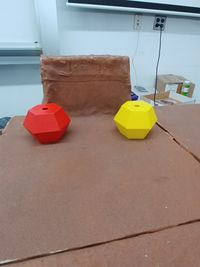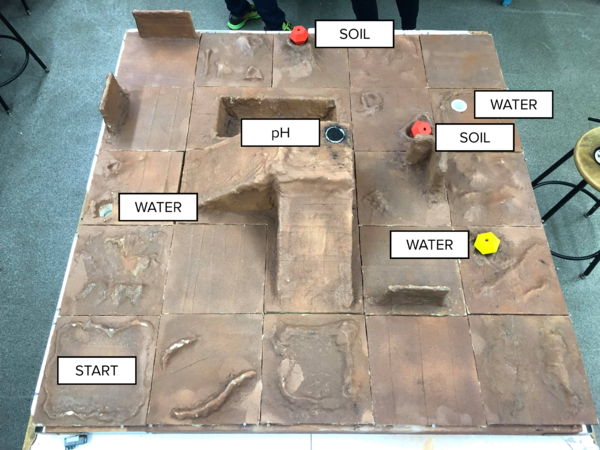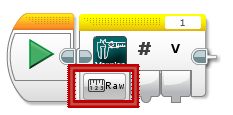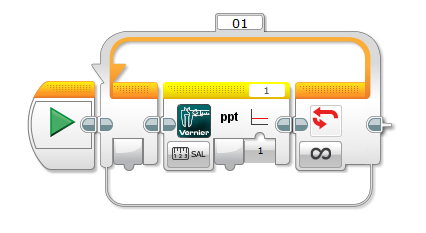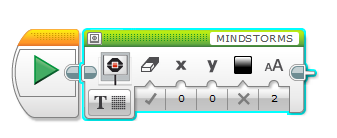Difference between revisions of "Mars Rover Robot Vex (MRR)"
| Line 60: | Line 60: | ||
Additional materials can be supplied by a TA.<br style="clear: both;" /> | Additional materials can be supplied by a TA.<br style="clear: both;" /> | ||
{{SLDP: Cost Estimate (Robots)}} | {{SLDP: Cost Estimate (VEX Robots)}} | ||
{{SLDP: Milestones and Benchmarks}} | {{SLDP: Milestones and Benchmarks}} | ||
{{SLDP: Milestone 1 (Robots)}} | {{SLDP: Milestone 1 (Robots)}} | ||
Revision as of 18:24, 14 June 2019
Request for Proposal: Mars Rover Robot (MRR)
This project reflects real life scenarios; the robot must be able to handle minor imperfections in the course.
This project reflects real life scenarios; the robot must be able to handle imperfections in the course.
Note: You should only use the materials contained in the Price list for VEX & Arduino parts for robot projects. If you want to use other parts, get permission from your faculty member to do so, and also to determine the cost of the parts you want to use that are not in this price list.
Introduction and Overview
The United States National Aeronautics and Space Administration (NASA) has received increased funding and have been able to reinstate the Constellation program. To help accelerate the process of development, NASA has issued an RFP (request for proposal) for a rover that will be used in the first of the Constellation missions. This rover will provide data about the landing site and begin preparations of the surrounding area to aid the manned missions arriving 26 months later. The robot should be able to get an accurate salinity reading of any water source, collect soil samples, travel across uneven terrain, and return to the landing site.
The mission has two parts that must be completed. The first part uses a salinity sensor to measure the salt content of one water source and a soil collection module to collect a soil sample, both taken by an autonomous robot (see Course Specifications for more details). The second part of this mission involves analyzing a water source and a soil sample. The water must be tested for salt content. There are two soil tests that the robot can choose from: a pH test and a compounds separation test. Once the tests are done, a conclusion must be reached about whether life can exist in the water sources on Mars, and (depending on the soil test) whether plants can potentially grow in the soil and/or if there is enough Fe2O3 and Fe3O4 to produce an adequate amount of rocket fuel.
Course Specifications
Use a CADing software, such as Fushion 360, to design the body of your robot. A model of your design must be built using the materials provided. An arduino program that will direct the robot's movements must be created. A cost estimate of the robot's components must be provided. All revisions to the original design must be recorded and explained. This includes technical design drawings and cost estimates. All revisions to the arduino program must be recorded and explained.
The Mars Rover Robot (MRR) must be able to move autonomously over the surface of Mars and collect salinity readings from a water source and a soil reading from a soil sample. Salinity readings will be taken using a salinity sensor while soil readings will be taken using a soil collection module. The robot must return to start to pick up the next module/sensor; if the robot can hold both the sensor and module while traversing the course, there is no need to go back to start between readings. The robot must finish in the start area, which is 25 cm by 25 cm. There is no height restriction. The part of the robot containing the Vernier sensor and collection modules must also fit within the size specifications.
Projectile (catapult, slingshot) designs are not allowed.
The robot program may not be altered or switched during any part of the mission. The robot must be fully autonomous and cannot be touched by any person during testing. Modules can be attached or placed on the robot so long as the robot is not shifted or altered in any way. Please refer to the course syllabus for all due dates.
The robot must return to the landing site to successfully complete the project.
Main Tasks
The first part of the mission requires the robot to:
- Collect one water reading using the Vernier salinity sensor
- Salinity sensor must be dipped into the water sample by the robot
- Collect one soil sample from a dig site using a collection module
- The robot must carry the collection module from the Start tile to the dig site
- Soil collection modules can be placed by hand onto the soil sample once the robot comes within 2 cm of the sample
- Collection modules are color coded; refer to the layout to determine which module to use
- Return to the landing site between readings unless the robot can hold both a module and the salinity sensor
- Return to the landing site after all readings are taken
Extra Credit
Extra Credit will be awarded if:
- The robot obtains 3 readings (at least 1 soil and 1 water)
- The robot crosses the canyon
- The robot travels up and down the mountain
- The robot takes a reading from an extra credit tile
Layout
Project Schedule
A project schedule must be created in Google Sheets. Please refer to the template provided in your team Google Drive folder and our guide.
This schedule must include all tasks related to the project from the start of the project to Early or Final submission. The project schedule should include:
- Minimum of 20 tasks, excluding Milestones
- Milestones should be clearly indicated on the project plan (duration of zero days)
- Each task must include the person responsible for completing the task (resource names)
- Gantt chart must be displayed alongside the tasks list (fit onto one slide)
- Gantt chart must show a progress line
- Clearly state during the presentations whether the project is on-time, behind schedule, or ahead of schedule
- In milestone presentations, please present a “Project Status” slide, which should summarize key deadlines. You are not required to show your project schedule in these presentations
Drawings
All drawings and sketches should be made using LEGO Digital Designer (LDD). LDD can be installed for free from the LEGO website.
Using LDD, create four drawings of the robot: front, top, most detailed side, and a drawing of the gear train(s). Sensors, motors, and gears must be included in each drawing. If the robot does not use any gears, make sure to explicitly state that in your presentations.
Each revision of the design must be documented and all changes must be presented during Milestone presentations.
Model
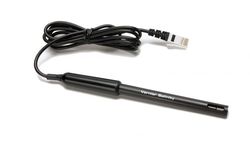
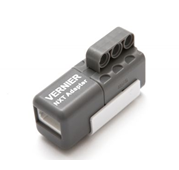
The following materials will be provided:
- VEX kit
* Please note that the salinity sensor and soil collection modules will only be available for use in the Model Shop.
Additional materials can be supplied by a TA.
Cost Estimate
Once a robot design is complete, a cost estimate must be generated that specifies the cost of all the materials and labor required for the construction of the design. Tabulate this cost information clearly in an Excel spreadsheet, using the materials cost list provided. Help in calculating the cost is available by reviewing How to plan the schedule and calculate costs for a project. The costs for the parts can be found on the Price list for Vex and Arduino parts for robot projects.
Note: You should only use the materials contained in the price list for LEGO parts for robot projects. If you want to use other parts, get permission from your faculty member to do so, and also to determine the cost of the parts you want to use that are not in this price list.
Create a cost estimate on a Microsoft Excel spreadsheet. The cost estimate should include the following:
- Labor cost breakdown with hours and rates
- Consolidate low-cost pieces: axles, beams, bricks, bushings, connectors, gears, plates
- Itemize high-cost pieces: arduino board, controllers, sensors
- No decimal places; this is an estimate after all. Round appropriately
- Total cost must be shown in the bottom right corner
Milestones, Benchmarks, and Deliverables
As work is done on the project, three Milestone presentations will report on the project's progress. All of the items assigned in each phase of the project are called Benchmark deliverables. These deliverables often consist of a combination of written submissions, presentations, and demonstrations. Benchmark assessments evaluate the progress of the project.
Preliminary Design Investigation
The Preliminary Design Investigation (PDI) is extremely important, as it lays the groundwork for the project. It outlines the project idea, inspiration, and goals.
The PDI must include:
- Cover Page
- Project Overview
- Goals & Objectives
- Design & Approach
- Cost Estimate
- Project Schedule
- Relevant Pictures
An example PDI template can be found here. The PDI is due by Benchmark A. Do not forget to include the items listed above. Use this link to access the VEX PDI Rubric.
Milestone 1
See How To Give a Milestone Presentation for the format of a Milestone presentation.
Milestone 1 is a presentation of the PDI. It is important that it outlines the project goals and show that the project is realizable.
The Milestone 1 presentation must include:
- Company profile
- Company name
- Product name
- Company officer title(s)
- Mission statement
- Project objective
- What is the project about?
- What tasks is the company aiming to accomplish? (Benchmark A requirements)
- Overall design approach to complete objective
- Background information
- Why is the project happening?
- What does the audience need to know?
- Technical design description
- Preliminary conceptual drawing of robot design
- Rendered and digital sketches are acceptable, CAD not required
- What components will be used and why?
- Preliminary conceptual drawing of robot design
- Cost estimate
- Major components of design listed
- Miscellaneous category listed
- Projected labor listed
- Microsoft Project schedule
- Click here to access the guide on how to transfer a file
- Teamwork agreement summary
- Summary
- Overall assessment on current state of project
- Is the project on schedule? Is it on budget?
- Next steps and future tasks
Look Ahead: What tasks are planned between now and Milestone 2?
Benchmark Assessment A
Benchmarks evaluate the progress of the project. Benchmark A is due at the end of Model Shop Session II. There are penalties for not completing this on time. Refer to the EG1004 Grading Policy for more information.
To pass Benchmark A, the design must complete all of the following:
- Obtain one soil reading from any of the four available soil sources
Milestone 2
See How To Give a Milestone Presentation for the format of a Milestone presentation.
Milestone 2 Deliverables:
- Presentation:
- Project description
- Design approach
- Design changes since Milestone 1
- Mission statement
- CAD drawings: top, front, most detailed side, isometric, gear train
- Mindstorms program
- Updated cost estimate (previous and current). What changes were made?
- Updated Microsoft Project schedule (previous and current). What changes were made?
- Progress update: current state of the project (time, budget, etc.)
Look Ahead: What tasks are planned between now and Milestone 3?
Benchmark Assessment B
Benchmark Assessment B is due at the end of Model Shop Session III. There are penalties for not completing this on time. Refer to the EG1004 Grading Policy for more information.
To pass, complete all of the following tasks:
- Obtain a first soil reading from any of the four available soil sources
- Return to the landing site to pick up salinity sensor if necessary
- Obtain a second reading from a water source
Milestone 3
See How To Give a Milestone Presentation for the format of a Milestone presentation.
Milestone 3 Deliverables:
- Presentation:
- Project description
- Design approach
- Design changes since Milestone 2
- Mission statement
- CAD drawings: top, front, most detailed side, isometric, gear train
- Mindstorms program
- Updated cost estimate (previous and current). What changes were made?
- Updated Microsoft Project schedule (previous and current). What changes were made?
- Progress update: current state of the project (time, budget, etc.)
Look ahead: What tasks are planned between now and the completion of the project?
Commissioning
Projects must be commissioned before Submission. Refer to the syllabus for Submission deadlines. There are penalties for not completing this on time. Refer to the EG1004 Grading Policy for more information.
To pass, the design must complete all of the following:
- Obtain a water and soil reading
- Return to the landing site
- Conduct all corresponding tests
- Completed Part 2 Template of test results from Data Specifications: Analysis
- NOTE: UAI students do NOT need to complete Part 2 in order to commission
Final Presentation
The Final Presentation will be a technical briefing, similar to the Milestones, but also serves as a sales presentation explaining why your company should be selected instead of the competition.
Your Final Presentation must include:
- Company profile
- Company name
- Employee profile, role(s), and qualifications
- Mission statement
- Problem statement
- Why is the project happening?
- What does the audience need to know?
- Project objective
- What is the purpose of your project?
- Who does your project help?
- What problem does your project solve?
- Project description
- Specify LEED certification
- Examples of LEED implementations in Revit
- Revit drawings
- All floor plan drawings
- Dimensions
- 1:240 scale
- Views of exterior of building: front elevation, side elevation, isometric elevation
- Dimensions
- Specify LEED certification
- Market and product viability
- Does your company have competitors?
- What makes your project unique?
- How does your design compare to competitors - cost, quality, features?
- Is the project versatile?
- What is the price of your project?
- Conclusion
- Reiterating project purpose
- Highlight project features
- Future goals of the company
- Why should your company be awarded this contract?
- Video pitch
- Price of project
- Walkthrough animation of building in Revit
- Embedded into Final Presentation
- Problem statement
- Solution overview
- Company description and qualifications
- Drawings
- Mindstorms program
- Cost estimate
- Microsoft Project schedule
- Video demonstration
- Why should the company be awarded this contract?
Submission
All SLDPs must be submitted online. Please visit this page for the link to the Project Submission form and each project’s individualized login information. To submit, login to the EG1004 website using this special login information. Submitting with an NYU account or any other account will generate an error. Components may be resubmitted at any time before the deadline. Please note that submission times are based on the most recent submission.
Please note the deliverables for this project are as follows. If any of the following items are omitted, there will be a penalty. Be sure to click "Submit" at the bottom of the form and allow sufficient time for uploading. The following list includes deliverable items that are required:
- Submission deliverables:
- Final presentation
- Final Mindstorms program
- Initial sketch
- All the drawings of your design (initial through final)
- Video
- Final MS Project Schedule
- Final cost estimate
- Resume(s) (No fictitious resumes will be accepted.)
- Completed Part 2 Template of test results from Data Specifications: Analysis
Late Submission
Late submission is not allowed. If a project does not Commission or receive Partial Commission by the deadline set forth in the syllabus, the project will not be allowed to submit and will receive a 0 for the project grade. To receive Partial Commissioning, two TAs must evaluate the project and determine its degree of completion according to the Commissioning requirements and the project will be given a grade accordingly. Please refer to the EG1004 Grading Policy for more information.
Frequently Asked Questions
Could we take readings from both the regular and extra credit options of a sample?
- No. You can only go for one sample in each category (i.e. cannot get both regular water and extra credit water)
Can we bump the course if the robot gets stuck?
- No. You can't bump Mars, so bumping the course is not an option.
Can we rubber band the soil collection module to the robot?
- No. The module has to be fixed to the robot using only EV3 pieces that came in your kit. Regular Legos cannot be used.
Can we put the soil collection module back on the robot once it's been placed on a soil sample?
- No. The soil collection module must remain on the soil sample for the rest of the robot's run.
Appendix: Programming with Vernier Sensors
In order to program the EV3 to obtain a reading using a Vernier sensor, a special sensor block that must be used. This block does not initially come with the EV3 programs, but can be easily downloaded. The computers in the Model Shop and all the EG lab rooms already have this sensor block on the programs. If you would like to download it onto your own computer, please look at the instructions below.
Downloading the Sensor Block: EV3
The instructions are the same for downloading the EV3 sensor block. On [www.vernier.com www.vernier.com], search for "Vernier EV3 Sensor Block" and click on the first link on the search results page.
Once at this webpage, click on "Download Vernier EV3 Sensor Block – Version 0.79" and save the "Vernier Sensor Block.ev3b" folder to a place where it can be accessed easily.
Start the EV3 software on your computer. At the top of the screen click on "Tools" -> "Block Import." A screen will pop up that looks very similar to the one in Figure 18. Click on "Browse" and search for the "Vernier Sensor Block.ev3b" file that was recently downloaded from the website. After a few seconds, the words "Vernier Sensor Block.ev3b" will appear in the box under "Name." Click on the name and hit import; the file will be downloaded.
Using the Sensor Block: EV3
Start the EV3 software on your computer and open a new program. On the bottom of the window, click on the yellow sensors palette, different sensors should be visible at the bottom of the screen. Click and hold on to the Vernier Sensor icon and drag it onto the main frame.
On the Vernier sensor block there should be button that says "Raw" right underneath the green picture that says Vernier. This button is shown in Figure 21.
After the button is pressed go to "Measure" -> "More Sensors" -> "Salinity ppt." You should see that the image looks similar to the one in Figure 22.
Now, we are going to create a program to make the robot continuously measure the salinity and display the reading on the EV3 brick. To do this, we must input a loop that can be found under the orange palette. Drag the loop onto the main frame. It should now look like the program in Figure 23.
- To change the runtime to a specific amount of time, click on the infinity symbol under the red arrows on the loop switch and change it to time, which can be found all the way at the bottom. Change the number to the right of the button to the desired time.
We are now going to have the salinity reading display on the EV3 brick. Go to the green palette at the bottom of the program, click on the display block and drag it onto the main frame. On the display block, click on the image folder and go to text, then pixels. The block should look like the one in Figure 24.
At the top of the display sensor block, the name "MINDSTORMS" is displayed. Click on the name and change it to "Wired." The block should look exactly the same except with one more slot immediately to the left of the spot with the check mark. Input the display block into the loop previously made and wire it like the picture in Figure 25. This program will now allow the salinity sensor to read the measurement and display it on the brick until the program is stopped.
- Note: For measuring salinity for Part 2, it's recommended to run the loop continuously in order to continuously display the salinity until the program is stopped.
References
| ||||||||
